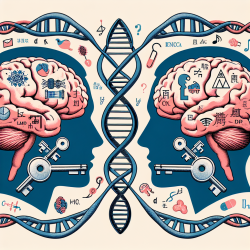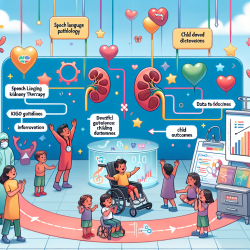Introduction
In the ever-evolving field of speech-language pathology, understanding the genetic factors that influence language development is crucial for improving educational and therapeutic outcomes. A recent study titled A genome-wide association study of Chinese and English language phenotypes in Hong Kong Chinese children provides groundbreaking insights into the genetic basis of literacy skills in bilingual children. This research, conducted on a sample of 1,046 Hong Kong Chinese children, explores the genetic associations with 34 reading and language-related phenotypes. The findings offer valuable implications for practitioners aiming to enhance their skills and encourage further research in this domain.
Key Findings
The study identified five independent genetic loci associated with various language and literacy traits, including Chinese vocabulary, character and word reading, and English lexical decision. These loci mapped to genes previously linked with educational attainment and neuropsychiatric phenotypes, highlighting the complex interplay between genetics and language skills.
Furthermore, the study employed polygenic risk score (PRS) analysis to examine the genetic overlap between these phenotypes and other cognitive and neuropsychiatric traits. Educational attainment and cognitive performance showed significant polygenic overlap with language traits, particularly English literacy skills. This suggests that genetic factors influencing general cognitive abilities may also impact language development.
Implications for Practitioners
For speech-language pathologists and educators, these findings underscore the importance of considering genetic factors when assessing and developing interventions for language and literacy difficulties. By understanding the genetic predispositions that may affect language skills, practitioners can tailor their approaches to better meet the needs of bilingual children.
- Personalized Interventions: Incorporating genetic insights can lead to more personalized and effective intervention strategies, addressing specific language challenges faced by children.
- Early Identification: Recognizing genetic markers associated with language difficulties can facilitate early identification and intervention, potentially mitigating long-term educational impacts.
- Encouraging Further Research: The study highlights the need for continued research into the genetic basis of language skills across different populations, which can inform global educational practices and policies.
Conclusion
The genetic insights provided by this study represent a significant step forward in understanding the biological underpinnings of language skills in bilingual children. For practitioners, integrating these findings into their practice can enhance the effectiveness of interventions and support better educational outcomes. As the field of speech-language pathology continues to evolve, embracing data-driven approaches will be key to unlocking the full potential of every child.
To read the original research paper, please follow this link: A genome-wide association study of Chinese and English language phenotypes in Hong Kong Chinese children.










